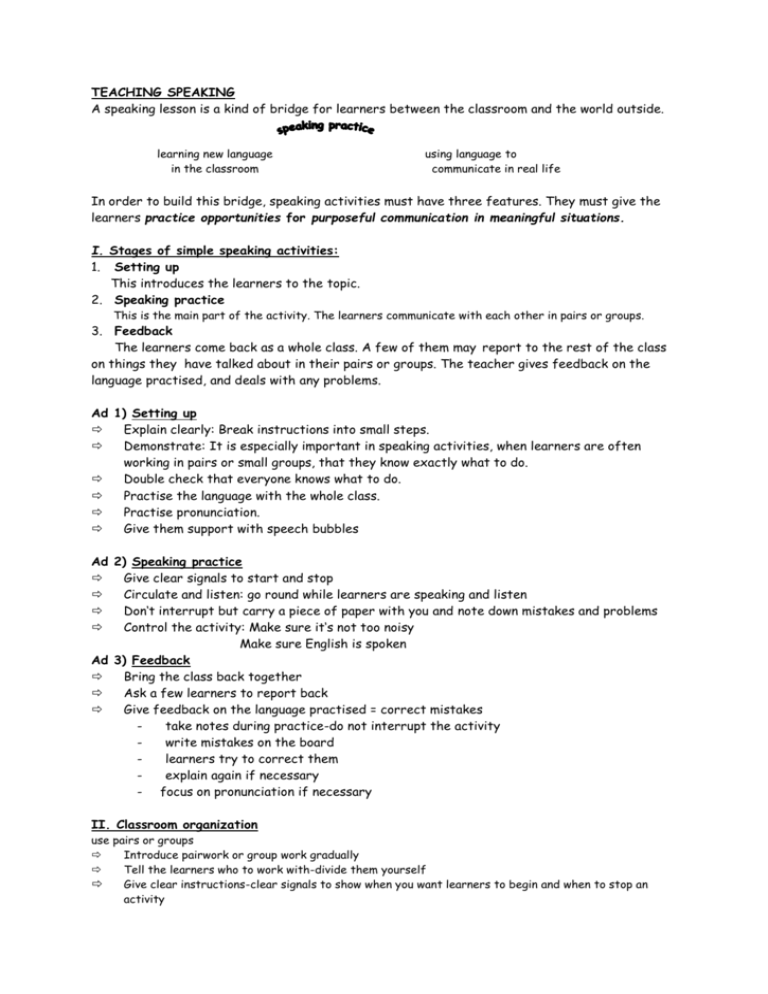TEACHING SPEAKING - Dana Hurtova
advertisement

TEACHING SPEAKING A speaking lesson is a kind of bridge for learners between the classroom and the world outside. learning new language in the classroom using language to communicate in real life In order to build this bridge, speaking activities must have three features. They must give the learners practice opportunities for purposeful communication in meaningful situations. I. Stages of simple speaking activities: 1. Setting up This introduces the learners to the topic. 2. Speaking practice This is the main part of the activity. The learners communicate with each other in pairs or groups. 3. Feedback The learners come back as a whole class. A few of them may report to the rest of the class on things they have talked about in their pairs or groups. The teacher gives feedback on the language practised, and deals with any problems. Ad 1) Setting up Explain clearly: Break instructions into small steps. Demonstrate: It is especially important in speaking activities, when learners are often working in pairs or small groups, that they know exactly what to do. Double check that everyone knows what to do. Practise the language with the whole class. Practise pronunciation. Give them support with speech bubbles Ad 2) Speaking practice Give clear signals to start and stop Circulate and listen: go round while learners are speaking and listen Don‘t interrupt but carry a piece of paper with you and note down mistakes and problems Control the activity: Make sure it‘s not too noisy Make sure English is spoken Ad 3) Feedback Bring the class back together Ask a few learners to report back Give feedback on the language practised = correct mistakes take notes during practice-do not interrupt the activity write mistakes on the board learners try to correct them explain again if necessary - focus on pronunciation if necessary II. Classroom organization use pairs or groups Introduce pairwork or group work gradually Tell the learners who to work with-divide them yourself Give clear instructions-clear signals to show when you want learners to begin and when to stop an activity Introducing pairwork If your class are new to pair and group work, you will need to introduce these ways of working carefully: Begin by using very short activities at the ends of lessons Make sure the learners are confident with the language and don‘t have to think too hard what to say while they are getting used to a new way of working--one new thing at a time is enough! So: Begin by getting them to read very short dialogues in pairs When they are happy doing this, go on to the ‘half-dialogue‘ technique with pairwork posters When they are confident with this, go on to an ‘ask and answer‘ type exercise, but practise the language well first and put the question and answer in speech bubbles on the board so they know what to say Then go on to the more demanding information gap exercises III. Speaking micro-skills It is probably true to say that when developing the speaking skills of lower level students (beginners to intermediates) teachers should spend most of the time getting students to practise the following: 1. Being able to use the language in real time (fluency). 2. Being able to pronounce the language sufficiently correctly to enable communication to take place. 3. Being able to use a range of vocabulary and grammatical structures (in the early stages, the range of grammatical structures students will use will be relatively small). 4. Talking about a range of common topics (eg family, school, hobbies, etc) 5. Expressing a wide range of functions. 6. Using different exponents to express the same function. 7. Selecting the appropriate exponent depending on the situation, their social status with regard to the person they are speaking to, the degree of formality/informality required, etc. 8. Knowing a range of basic scripts (how to start and finish a conversation, how to buy things in a shop or order in a restaurant, etc). 9. Being able to cope with insufficient language resources, by paraphrasing, simplifying, inventing a word, using the L1 as a resource, miming, using hesitation devices, etc. 10. Being able to cope with communication breakdowns, eg when they simply don't understand (by asking for repetitions, etc). 11. Using intonation to convey meaning. Other speaking skills include: 12. Interpreting and using indirect speech acts (such as Are you going past the post box?, meaning Could you post this letter for me?). 13. Being able to take turns smoothly and appropriately. 14. Using appropriate fillers and responses to ensure continued input. 15. Give dispreferred answers to questions.







